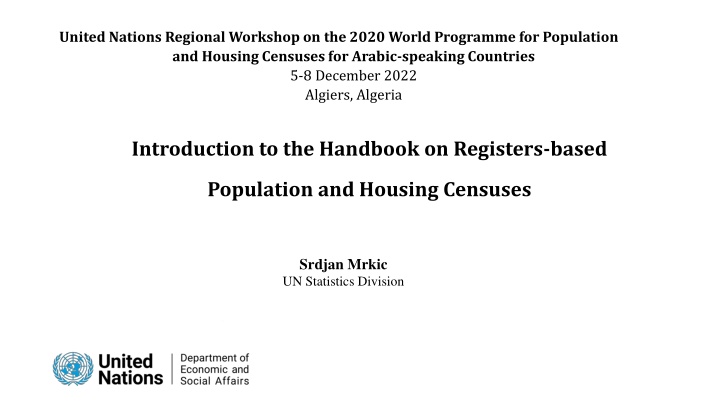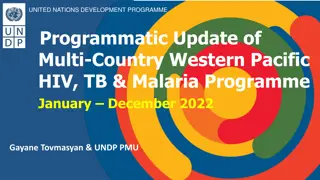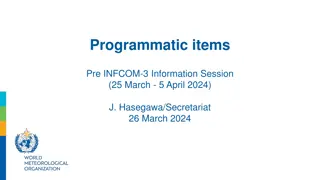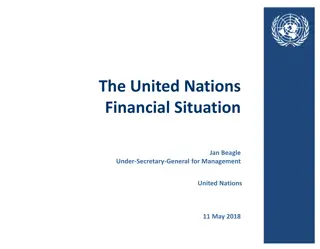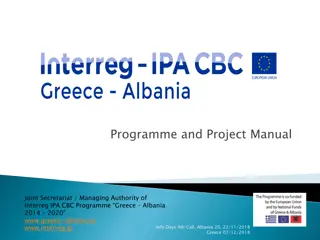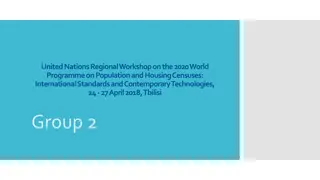United Nations Regional Workshop on 2020 World Programme for Population and Housing Censuses
This model provides a holistic approach to civil registration, vital statistics, and identity management as recommended by the United Nations. It emphasizes the use of administrative registers to produce census statistics efficiently, with a focus on cost reduction, data quality improvement, and more frequent data updates. The interest in utilizing administrative registers has grown, particularly due to the Covid-19 pandemic.
Download Presentation

Please find below an Image/Link to download the presentation.
The content on the website is provided AS IS for your information and personal use only. It may not be sold, licensed, or shared on other websites without obtaining consent from the author.If you encounter any issues during the download, it is possible that the publisher has removed the file from their server.
You are allowed to download the files provided on this website for personal or commercial use, subject to the condition that they are used lawfully. All files are the property of their respective owners.
The content on the website is provided AS IS for your information and personal use only. It may not be sold, licensed, or shared on other websites without obtaining consent from the author.
E N D
Presentation Transcript
United Nations Regional Workshop on the 2020 World Programme for Population and Housing Censuses for Arabic-speaking Countries 5-8 December 2022 Algiers, Algeria Introduction to the Handbook on Registers-based Population and Housing Censuses Srdjan Mrkic UN Statistics Division World s Women Report 2020: Trends and Statistics Photo: UN Women/Allison Joyce
This model represents a holistic approach to civil registration, vital statistics and identity management recommended by the United Nations, adapted from the United Nations Principles and Recommendations for a Vital Statistics System, Revision 3.; it can be adjusted to national circumstances and governing structures as necessary. Ministry of Health Public health reports Statistics morbidity Health Inf. System Complementary and Interim sources Population census Surveys Live birth Civil Registration NSO - Vital Statistics Health services Certification of cause of death Relatives, midwifes Death Vital Statistics 1.Compulsory 2.Universal 3.Continuous/ Permanent 4.Confidential Compilation Processing Validation Quality control Dissemination Fetal death Civil Informants Registration Authorized institutions Marriage Confers legal identity Additional Sources Coronary Police Pop.Register ID Mgmt. CR DB Vital St. DB Divorce Annulments Courts Judicial separation Population Register Unique ID Access protocols Statistical population registers Judicial institutions Administrative/Functional registers Education Employment Tax Social assistance Pensions Voters . Adoption PR DB Legitimation NSO Register based census-like small area statistics referencing Big data Recognition Surveys Informants Geo- Identity Management Agency and Services Biometric ID, passports Capture (enrolment) Identification Verification Online and e-services Matching Civil Registration, Vital Statistics and Identity Management System
Register Register- -based censuses based censuses Statistical population registers Labour force survey Household expenditure survey Housing conditions survey Social conditions survey referencing Big data Surveys NSO Register based census- like small area statistics Address registers Geo-referenced census master file Geo-spatial information merging Geo- Big data commuting, services, location Matching
Introduction Administrative registers generated by governments and service providers are becoming an increasingly important source of data for official statistics, particularly for producing census information o 51st session of UN Statistical Commission (2020) requested the development of methodological document on the use of administrative sources for generating census statistics Using opportunities in conducting censuses, in particular for reducing costs, improving the quality of data and producing more frequent information in many cases on a yearly basis administrative sources offers many o The arrival of the Covid-19 pandemic has accelerated the interest in the use of administrative registers and/or sources for the census o Statistics Division
Objectives of the Handbook Overall objective of this handbook is to provide advice to NSOs, planning to use administrative registers for the production of census information The handbook elaborates on how to transform from a traditional census to other census methodologies involving the use of registers The handbook builds on the work and outputs that have been prepared by the Conference of European Statistics, most notably o Guidelines on the use of registers and administrative data for population and housing censuses o Guidelines for assessing the quality of administrative sources for use in censuses It also incorporates practices, challenges and lessons learned by those NSO s with previous experience in the use of administrative data for producing census information Statistics Division
Overview of the handbook The draft handbook contains six chapters Chapter 1 Introduction - the rationale for moving to a register-based statistical system, definition of a register, overview of census methodologies Chapter 2 - Moving to a register-based approach- necessary pre-conditions, difficulties and challenges and possible solutions Chapter 3 - Types of administrative source- base registers and specialised or supplementary registers Chapter 4 Transforming administrative data into census data- a statistical population register, constructing integrated statistical registers Chapter 5 Quality assessment quality dimension and stages of quality assessment (source, input data, process and output) Chapter 6 - Conclusions and recommendations- provides some key recommendations that each NSO should consider when they plan and design any programme to transition from a traditional census to other approaches Statistics Division
Overview of the draft handbook Case Studies (in progress) A number of case studies will be included in Appendix to illustrate how particular issues and challenges were met by some of those countries that have already transitioned to a register-based or combined census, or are in the process of preparing to do so. o UNSD will reach out the EG members to prepare a case study for particular issues Statistics Division
Rationale The rationale for using administrative sources for PHCs ... potential opportunities for: reducing costs reducing respondent burden recent incentives, e.g., increased interest during the COVID-19 pandemic to reduce direct contact with the general public with the use of administrative data and online data collection methods improving the quality of data improving efficiency producing more frequent information in many cases on a yearly basis may be particularly relevant for the purposes of annual monitoring of SDGs indictors national commitments to modernize statistical systems, e.g., NSO s long-term vision for a developing a more general register-based statistical system national legal and political factors (e.g., digital government or e-Government initiatives) stakeholders and users expectations Statistics Division
Key definitions What is a register ? a systematic collection of unit-level data organized in such a way that updating is possible, where updating is the process of adding or changing identifiable information with the purpose of establishing, bringing up to date, correcting or extending the register - keeping track of any changes in the data describing the units and their attributes Administrative registers -whether held by public bodies or private sector organisations- are produced for the purpose of effecting administrative processes by recording information on units (such as persons and dwellings) and variables that are defined by administrative rules and demands in a country Statistics Division
Key definitions A register will contain information on a complete group of units, referred to as the target population, such as persons, dwellings, buildings or business organisations Such units are defined by a precise set of rules in order to fulfil the function of the register and the attributes (variables) are updated in line with changes affecting the units for example, a set of rules can be used for identifying the resident population in a country, such as duration of residence, residence permit or work permit, etc. Statistical registers are created national statistical authorities by processing data from administrative registers for statistical purposes in accordance with statistical concepts and definitions. A statistical register could be based on one or more administrative registers Statistics Division
Essential features of administrative registers that can be used for statistical purposes They should be systematic that is regular and organized The data held should be at the unit record level They should be capable of being updated Statistics Division
Necessary preconditions The NSO s long-term strategic vision for a register-based statistical system Moving to a register-based (or combined) census is a core part of the strategy for the NSO to develop or adopt a register-based statistical system. This strategy will transform the statistical production system, and so represents a paradigm shift for all functional aspects of the NSO Political support and the legal framework Obligations on the relevant administrative agencies to provide the required administrative unit record data and any relevant metadata and Give the NSO legal authority to access the relevant administrative data at individual level, from any relevant public authority source In addition to a legal framework and good contacts with other authorities, signing cooperation contracts or service level agreements could help in supporting the NSO s statistical programmes Statistics Division
Necessary preconditions Public support, confidentiality and user engagement While the law might give a legal licence for the NSO to conduct a combined or register-based census, public approval is also necessary to ensure that such a census is acceptable The public should have full confidence that the privacy and confidentiality of those data are protected, and that data are only used for statistical purposes The attitude of the public to data linking and sharing between government agencies is a key factor in determining the extent to which administrative data can be used for statistical purposes Cooperation between NSO and register-holders Good cooperation between the NSO and other (mainly government) authorities is vital for using administrative data sources in statistical systems, and for the census in particular In addition to a legal framework, signing cooperation contracts or service level agreements could help in supporting the NSO s statistical programmes and particularly the census process This will help to engender a better understanding among administrative agencies of the role that their data play in the statistical system Statistics Division
Necessary preconditions Knowledge of the relevant administrative registers and initial assessment of their quality Building up a wide-ranging knowledge of the data held in administrative sources that are both relevant and fit for purpose is important before making the move Assessing possible sources for all the census topics required by users, as well as sources for the base registers this assessment will include identifying the availability, accessibility and suitability of different sources -and ultimately each variable within each source Unified identification system Unique ID-numbers at the unit record level that are common across all respective registers the application of a unique (statistical) ID should occur during data integration and pre-processing within the NSO- data confidentiality Statistics Division
Necessary preconditions Institutional infrastructure and capacity In order to move to a register-based system, o it will be necessary for NSO staff to develop beforehand a full range of appropriate skills o it is important to recognise that a register-based statistical system will require statistical knowledge and expertise, particularly in the linkage and matching of data in general, information management, data mining and analysis, data protection, communication, and associated subject matter skills Necessary for the NSO to develop an infrastructure, and to implement a training programme, that is designed to help staff acquire the requisite statistical and IT skills to support the necessary transformation processes Statistics Division
Difficulties and challenges Lack of a unified identification system Greater dependency on public authorities Missing data and the under-coverage of some populations Differences in concepts and definitions Definition of place of usual residence in population register ? Classification systems Maintaining IT infrastructure Privacy and security concerns Inconsistency between registers Resistance to change Timeliness and reference periods Diminishing interest Statistics Division
